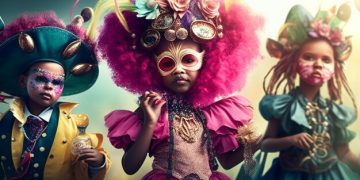The Ultimate Guide to Cosplay: From Beginner to Pro

Cosplay is the art of dressing up as characters from various forms of media, such as video games, anime, comic books, and movies, involving costume construction, performance, and a passion for bringing fictional characters to life.
Are you ready to transform into your favorite character? Cosplay, or costume play, is more than just dressing up; it’s an immersive art form that combines creativity, craftsmanship, and a deep love for pop culture. Whether you’re a newbie or looking to level up, this guide will help you navigate the exciting world of cosplay.
What is Cosplay and Why is it So Popular?
Cosplay, short for costume play, is the practice of dressing up as a character from a movie, book, video game, or any other form of media. It’s a hobby that allows fans to express their admiration and connection to their favorite characters.
But why has cosplay become so incredibly popular? It’s more than just dressing up; it’s about embodying the character, showcasing creativity, and connecting with like-minded individuals. The sense of community and shared passion are major draws for cosplayers of all levels.
The Definition of Cosplay
At its core, cosplay involves creating and wearing costumes to represent a specific character. This can range from simple, store-bought outfits to elaborate, handmade creations that require hundreds of hours of work.
The Appeal of Cosplay
Cosplay’s popularity stems from several factors. It offers a creative outlet, allowing individuals to express their artistic talents through costume design and performance. It also provides a sense of community, connecting cosplayers at conventions and online.
- Creative Expression: Cosplay allows individuals to express their creativity through costume design and construction.
- Community Connection: Cosplay brings people together at conventions and online, fostering a sense of belonging.
- Character Embodiment: Cosplayers enjoy embodying their favorite characters, bringing them to life in a tangible way.
- Skill Development: Cosplay helps individuals develop skills in sewing, crafting, makeup, and performance.
In conclusion, cosplay is both a creative hobby and a social activity. Its appeal lies in the opportunity to express oneself, connect with others, and celebrate beloved characters and stories.
Getting Started with Cosplay: A Beginner’s Guide
Embarking on your cosplay journey can seem daunting, but it doesn’t have to be. Starting with simple projects and gradually increasing complexity is a great way to learn the ropes.
From choosing your first character to gathering materials and learning basic techniques, this section will guide you through the essential steps to get started with cosplay.
Choosing Your First Character
Selecting the right character is crucial for a successful first cosplay. Opt for a character whose appearance is relatively simple and that you genuinely enjoy. This will make the process more enjoyable and less overwhelming.
Gathering Materials and Tools
Once you’ve chosen your character, the next step is to gather the necessary materials and tools. This might include fabric, foam, paint, a sewing machine, and various hand tools. Start with the basics and gradually expand your collection as needed.

- Fabric: Choose fabrics that are appropriate for your character’s outfit, considering texture, color, and durability.
- Foam: EVA foam is a popular choice for armor and props due to its lightweight and easy-to-shape properties.
- Paint: Acrylic paints are versatile and can be used on a variety of materials, while specialized weathering paints can add realism to your cosplay.
- Sewing Machine: A sewing machine can greatly speed up the process of creating fabric-based costumes.
In summary, starting with a simple character, gathering essential materials, and learning basic techniques will provide a solid foundation for your cosplay journey. Remember, every experienced cosplayer started somewhere, so don’t be afraid to start small and gradually improve your skills.
Essential Cosplay Techniques: Sewing, Crafting, and Wigs
Mastering a few key techniques can significantly enhance the quality and realism of your cosplays. Sewing, crafting, and wig styling are skills that every cosplayer should develop over time.
In this section, we’ll explore these essential techniques, providing tips and tricks for achieving professional-looking results.
Sewing Basics for Cosplay
Sewing is a fundamental skill for creating fabric-based costumes. Learning basic stitches, pattern making, and garment construction will allow you to create custom-fit outfits that accurately reflect your character’s attire.
Crafting Props and Armor
Many cosplay characters require props and armor, which can be crafted from a variety of materials, including foam, plastic, and wood. Learning how to cut, shape, and assemble these materials is essential for creating realistic and durable props.

- EVA Foam Crafting: Learn how to cut, shape, and glue EVA foam to create lightweight and durable armor pieces.
- Worbla Shaping: Experiment with Worbla, a thermoplastic material that can be molded into intricate shapes with heat.
- 3D Printing: Use 3D printing to create complex and detailed props that would be difficult to make by hand.
- Painting and Weathering: Master techniques for painting and weathering your props to give them a realistic and battle-worn appearance.
Ultimately, mastering sewing, crafting, and wig styling are essential for creating high-quality cosplays. By investing time and effort into developing these skills, cosplayers can bring their favorite characters to life with accuracy and attention to detail.
Leveling Up Your Cosplay: Advanced Techniques and Materials
As you become more experienced with cosplay, you may want to explore more advanced techniques and materials to take your creations to the next level. This might involve learning more complex sewing techniques, working with specialized materials, or incorporating electronics into your designs.
This section will delve into some of these advanced techniques, offering inspiration and guidance for experienced cosplayers looking to push their boundaries.
Working with Specialty Fabrics
Specialty fabrics, such as leather, vinyl, and stretch fabrics, can add a unique and professional look to your cosplays. However, they often require specialized sewing techniques and equipment. Experimenting with these materials can open up new possibilities for your designs.
Incorporating Electronics
Adding lights, sound effects, and moving parts to your cosplays can create a truly immersive experience. Learning basic electronics and programming can allow you to bring your characters to life in exciting new ways.
Cosplay is a journey of continuous learning and improvement. By embracing new techniques, experimenting with different materials, and seeking inspiration from other cosplayers, you can continue to evolve your skills and create truly exceptional cosplays.
Cosplay and Conventions: Showcasing Your Work
Attending conventions is a significant part of the cosplay experience. It provides an opportunity to showcase your work, connect with other cosplayers, and participate in contests and events.
In this section, we’ll discuss how to prepare for conventions, what to expect, and how to make the most of your time there.
Preparing for Conventions
Before attending a convention, it’s essential to plan ahead. This includes registering for the event, booking accommodations, and planning your cosplay lineup. It’s also a good idea to pack a cosplay repair kit, as accidents can happen.
Navigating Conventions
Conventions can be overwhelming, especially for first-timers. Familiarize yourself with the convention map, schedule, and rules. Be prepared to navigate crowds, stand in lines, and interact with other attendees.
- Stay Hydrated: Drink plenty of water throughout the day to stay hydrated and prevent fatigue.
- Take Breaks: Take regular breaks to rest and recharge, especially if you’re wearing a heavy or uncomfortable costume.
- Be Respectful: Treat other attendees, staff, and cosplayers with respect. Remember that cosplay is not consent.
- Have Fun: Relax, enjoy the atmosphere, and embrace the opportunity to connect with fellow fans.
Attending conventions is a rewarding experience for cosplayers. By planning ahead, staying organized, and being respectful, you can make the most of your time at the event and create lasting memories.
The Cosplay Community: Etiquette and Support
The cosplay community is a vibrant and diverse group of individuals who share a passion for costume play. Like any community, it has its own set of etiquette and expectations.
In this section, we’ll discuss the importance of respectful behavior, positive interactions, and supporting fellow cosplayers.
Respectful Behavior and Etiquette
Treating others with respect is essential in the cosplay community. This includes asking for permission before taking photos, avoiding derogatory comments, and respecting personal boundaries. Remember that cosplay is not an invitation for harassment or unwanted attention.
Supporting Fellow Cosplayers
The cosplay community thrives on support and encouragement. Offer compliments, share tips and advice, and celebrate the accomplishments of fellow cosplayers. A positive and supportive environment fosters creativity and camaraderie.
In essence, the cosplay community is built on respect, support, and shared passion. By adhering to these principles, you can contribute to a positive and inclusive environment for all cosplayers.
| Key Aspect | Brief Description |
|---|---|
| 🎭 Understanding Cosplay | Cosplay involves embodying characters via costumes, appealing to creativity and community. |
| 🧵 Essential Techniques | Skills like sewing, crafting armor, and styling wigs augment cosplay quality. |
| 🛡️ Advanced Materials | Using specialized fabrics, electronics, and advanced techniques sharpens your skills. |
| 🤝 Community & Conventions | Showcasing work and respecting cosplay etiquette at conventions is vital. |
Frequently Asked Questions About Cosplay
▼
Opt for a character you love and whose outfit complexity aligns with your current skills. Simpler designs are often best for beginners, allowing you to focus on learning techniques.
▼
Cosplay costs vary widely based on materials and complexity. Budget cosplays can cost under $50, while intricate pieces can reach hundreds or even thousands. Planning helps.
▼
Key tools include a sewing machine, cutting tools, a heat gun, and various paints and adhesives. Starting with basics and expanding as needed is advisable for new cosplayers.
▼
Always carry a repair kit with items like needles, thread, glue, and safety pins. Quick fixes can save the day and ensure you enjoy the convention without major wardrobe issues.
▼
Store cosplays in garment bags or containers to prevent dust and damage. Clean each piece according to its material type. Proper storage maximizes the longevity of your creations.
Conclusion
Cosplay is an ever-evolving art that blends creativity, craftsmanship, and community. From the initial spark of inspiration to the final flourish of performance, each step offers a chance for personal expression and connection. Whether you’re a seasoned pro or just starting, the world of cosplay welcomes all who dare to dream and create. Dive in, be bold, and let your imagination take flight.





